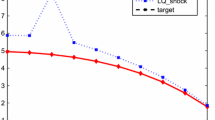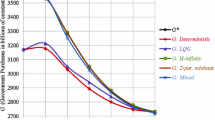Abstract
Local (perturbation) methods compute solutions in one point and tend to deliver far lower accuracy levels than global solution methods. We develop a hybrid method that solves for some policy functions locally (using a perturbation method) and that solves for the other policy functions globally (using closed-form expressions and a numerical solver). We applied our hybrid method to solve large-scale RBC models used in the comparison analysis of Kollmann et al. (J Econ Dyn Control 35:186–202, 2011b). We obtain more accurate solutions than those produced by any other (either local or global) solution method participating in that comparison. Our running time is a few seconds.
Similar content being viewed by others
References
Adjemian, S., Bastani, H., Juillard, M., Mihoubi, F., Perendia, G., Ratto, M., & Villemot, S. (2011). Dynare: Reference manual, Version 4. Dynare Working Papers 1, CEPREMAP, Paris.
Aruoba S., Fernández-Villaverde J., Rubio-Ramírez J. (2006) Comparing solution methods for dynamic equilibrium economies. Journal of Economic Dynamics and Control 30: 2477–2508
Chen B., Zadrozny P. (2009) Multi-step perturbation solution of nonlinear differentiable equations applied to an econometric analysis of productivity. Computational Statistics and Data Analysis 53(6): 2061–2074
Collard F., Juillard M. (2001) A higher-order Taylor expansion approach to simulation of stochastic forward-looking models with an application to a nonlinear Phillips curve model. Computational Economics 17: 125–139
Den Haan W.J., De Wind J. (2012) Nonlinear and stable perturbation-based approximations. Journal of Economic Dynamics and Control 36(10): 1477–1497
Dotsey M., Mao C. S. (1992) How well do linear approximation methods work? The production tax case. Journal of Monetary Economics 29: 25–58
Galassi, M., Davies, J., Theiler, J., Gough, B., Jungman, G., Booth, M., & Rossi, F. (2003). GNU Scientific Library: Reference Manual. Bristol: Network Theory Ltd.
Gaspar J., Judd K. (1997) Solving large-scale rational-expectations models. Macroeconomic Dynamics 1: 45–75
Gomme P., Klein P. (2011) Second-order approximation of dynamic models without the use of tensors. Journal of Economic Dynamics and Control 35: 604–615
Jin, H., & Judd, K. (2002). Perturbation methods for general dynamic stochastic models. Manuscript. Stanford University.
Judd K. (1992) Projection methods for solving aggregate growth models. Journal of Economic Theory 58: 410–452
Judd K. (1998) Numerical Methods in Economics. The MIT Press, London
Judd K., Guu S. (1993) Perturbation solution methods for economic growth models. In: Varian H. (Ed.), Economic and Financial Modeling with Mathematica. Springer, New York, pp 80–103
Judd K., Maliar L., Maliar S. (2011a) Numerically stable and accurate stochastic simulation approaches for solving dynamic economic models. Quantitative Economics 2: 173–210
Judd, K., Maliar, L., & Maliar, S. (2011b). How to solve dynamic stochastic models computing expectations just once, NBER working paper 17418.
Juillard M., Villemot S. (2011) Multi-country real business cycle models: accuracy tests and testing bench. Journal of Economic Dynamics and Control 35: 178–185
Kim J., Kim S., Schaumburg E., Sims C. A. (2008) Calculating and using second-order accurate solutions of discrete time dynamic equilibrium models. Journal of Economic Dynamics and Control 32: 3397–3414
Kollmann R., Kim S., Kim J. (2011a) Solving the multi-country real business cycle model using a perturbation method. Journal of Economic Dynamics and Control 35: 203–206
Kollmann R., Maliar S., Malin B., Pichler P. (2011b) Comparison of solutions to the multi-country real business cycle model. Journal of Economic Dynamics and Control 35: 186–202
Lombardo, G. (2010). On approximating DSGE models by series expansions. European Central Bank working paper 1264.
Maliar L., Maliar S. (2003) The representative consumer in the neoclassical growth model with idiosyncratic shocks. Review of Economic Dynamics 6: 362–380
Maliar, S., Maliar, L., & Judd, K. (2010). Solving the multi-country real business cycle model using ergodic set methods. NBER working paper 16304.
Maliar S., Maliar L., Judd K. (2011) Solving the multi-country real business cycle model using ergodic set methods. Journal of Economic Dynamic and Control 35: 207–228
Malin B., Krueger D., Kubler F. (2011) Solving the multi-country real business cycle model using a Smolyak-collocation method. Journal of Economic Dynamics and Control 35: 229–239
Pichler P. (2011) Solving the multi-country real business cycle model using a monomial rule Galerkin method. Journal of Economic Dynamics and Control 35: 240–251
Schmitt-Grohé S., Uribe M. (2004) Solving dynamic general equilibrium models using a second-order approximation to the policy function. Journal of Economic Dynamic and Control 28: 755–775
Swanson, E., G. Anderson, & Levin, (2006). Higher-order perturbation solutions to dynamic, discrete-time rational expectations models. Federal Reserve Bank of San Francisco working paper 1.
Author information
Authors and Affiliations
Corresponding author
Rights and permissions
About this article
Cite this article
Maliar, L., Maliar, S. & Villemot, S. Taking Perturbation to the Accuracy Frontier: A Hybrid of Local and Global Solutions. Comput Econ 42, 307–325 (2013). https://doi.org/10.1007/s10614-012-9342-y
Accepted:
Published:
Issue Date:
DOI: https://doi.org/10.1007/s10614-012-9342-y




